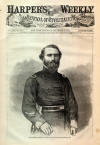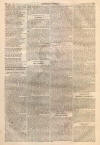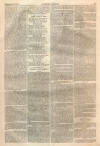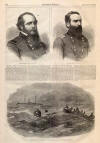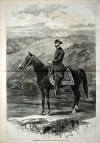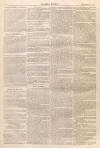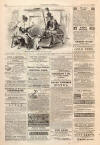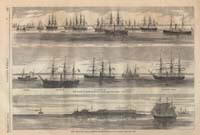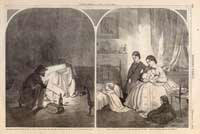AESTHETICO NEURALGICON
|
|
This Site:
|
DECEMBER 17, 1864.] HARPER'S WEEKLY. 813 [From the New York Express.]DR. VON EISENBERG'S AESTHETICO-NEURALGICON.So numerous are the " Schools" of Medicine, and so bitterly does each of them denounce the theory and practice of all the others, it is no wonder that many persons have come to the conclusion that there is no such thing as a Science of Medicine, and that all medical practice is mere guess-work, if not actual humbug. But this hasty conclusion is wholly erroneous. The existence of so many schools and theories shows that many men are busy gathering facts, making investigations, and trying to master their significance. The great error is that each school in theory ignores the truth and science contained in the others, though in fact the practice of all the schools is gradually assimilating. Thus no able Allopathist now administers in any ordinary case the enormous doses which were once the rule ; and no able Homeopathist adheres to the infinite Illutions of Hahnemann. So many able and earnest men are devoting themselves to medical investigation that it would be strange if new discoveries were not made. Among the most brilliant of these we may indeed say the most brilliant of all is that of Dr. Vox EISENBERG in regard to the Etherealization of Medicines ; we may properly call it the " Spiritualization," since the Latin Spiritus, whence comes our word " Spiritual," signifies primarily simply " the air." This discovery of Dr. VON EISENBERG, like most other discoveries, is apparently so simple when once made, that the wonder seems to be that it was not made and practically applied long ago. The greatest single advance made in medical theory since the days of Hippocrates, is that of Hahnemann, that the potency of medicines depends not so much upon the quantity taken into the system as upon their minute subdivision, so that they may be brought into immediate contact with the affected organs. He indeed carried his theory to an absurd extent, diluting and rediluting until there was only a drop of medicine to many hogsheads of water. Hahnemann and his followers, the homeopathists, knew of no more efficient vehicle of dilution than water. They thus fell just short of that which constitutes the starting point of the brilliant discovery of VON EISENBERG, to whom it occurred that if the air could he practically applied to this purpose, the most minute subdivision could be attained without the excessive dilutions of the Homeopathists. Medicines could then be inhaled or breathed in, instead of being merely swallowed, and thus a class of organs be directly reached which had heretofore been inaccessible to the direct action of medicines. Many of the most important and vital organs of the human frame can not be reached by medicines in a solid or even in a liquid form. Thus the lungs are shut up in a bony chest to which access can. be had only through the wind-pipe, the opening of which is closed by a valve called the "epiglottis," so sensitive and so delicately constructed that it will not allow the passage, except by main force, of the most minute crumb or the smallest drop of liquid. Every person who has "swallowed the wrong way'' the smallest substance, whether of liquid or solid, knows the feeling of strangulation thereby occasioned. A man can not, if he would, voluntarily swallow any liquid or solid into the lungs or the passage leading to them. Herein lies the true reason why Consumption has been so incurable. The classes of diseases commonly known by the name of Consumption are essentially of two kinds. One consists of the formation of "tubercles," that is ulcers in the body of the lungs; the other of inflammation of the lungs or the passage leading to them. If we could reach these organs directly by medicinal applications, there is no reason why ulcerations or inflammations of the lungs might not be cured as readily as those upon the hand or face. Now pills or draughts, when swallowed, do not go near the lungs; they pass down the " gullet" into the stomach. To take pills or potions with the hope of directly curing Consumption, is as absurd as to take them to cure a boil on the arm or an inflammation of the eyelid. Indirectly, of course, the proper pills and draughts are of aid in all of these affections, by benefiting the general tone of the system, and thus enabling it the more readily to throw off disease. But directly, we can not too often repeat, they are of no use, for the very sufficient reason that they do not touch the diseased organ. Medicines can only touch the lungs when administered, not in a solid or liquid, but in an aeriform or " spiritualized" form. These remarks apply equally to diseases of the passages leading from the nostrils to different parts of the head, such as the throat and ear. These diseases, though not so fatal as Consumption, are yet often dangerous, and always annoying. Few persons are unacquainted, more or less, with the annoyances of colds, catarrhs, and influenzas. Taste, smell, hearing, and sight are impaired and not unfrequently destroyed temporarily, and sometimes permanently, by these diseases. Such is a brief outline of some of the facts which led Dr. VON EISENBERG, acting in the spirit of the Baconian philosophy, to the discovery of the theory of the Etherealization, or Spiritualization, of Medicines. The next task to which he set himself was to find some means of making his discovery of practical use, by inventing some mode of administering medicines in an ethereal form. The ordinary modes were clearly unavailing. You can not administer air by a tea-spoon. After the labor of two years, and an outlay of $7000, he succeeded in perfecting the apparatus of which the accompanying illustration gives a view, and which we shall now attempt briefly to describe. On entering Vox EISENBERG'S consulting room the visitor will observe what appears to be three distinct machines, of elegant form and exquisitely finished workman ship. These are, however, but parts of one apparatus, the connection between them being made beneath the floor. First there is what appears to be the beam of a double engine, elegantly finished in silver, which, by pressure, produces an atmosphere entirely purified of all foreign or deleterious substances. This atmosphere is forced by this instrument into a large cylinder constructed under the floor of the basement, capable of receiving two hundred and fifty pounds of condensed air. From this cylinder the purified atmosphere is made to pass into a second large cylinder or chamber previously impregnated with hot medicated vapors. From this second chamber, by opening a valve, the air, now thoroughly medicated, is permitted to proceed to the operating room, where it is received into a second piece of mechanism, which presents the appearance of a triumphal arch supported by two hollow silver columns, into which the prepared air passes, into a third chamber of pure silver, built between the columns, and forming the crown of the arch, where it is again mixed with various medicinal preparations. From this chest the spiritualized medical vapor is passed, when required, through a second invisible channel, to what appears to be the third machine or apparatice a beau tiful and elaborate instrument, consisting of not less than twenty-four magnificent crystal glass vessels, each charged with a different medical preparation. The largest of these vessels is capable of containing two gallons ; four, one gallon each ; ten receivers, that hold each one pint ; eight, one half pint each ; and one vessel, holding a pint, arranged with a neck like a douche, and with the single object in view of restoring health to the eye ; end another, similarly constructed, the end somewhat similar to the month piece of an ear trumpet, which is used for the sole purpose of acting energetically upon the auric nerve. Besides these twenty four vessels, there are four others capable of holding one quart of fluid each, to which are attached very elegant velvet tubes, which are to be used as inhalers, so mechanically arranged that the patient, once he places one of them to his lips, must inhale the medicament of the vessel to which the tube is attached. The peculiarity of these tubes rests in the fact that the sufferer is compelled, however unaccustomed to their use, to breathe in the medicine. He can not refuse to receive into his throat and lungs a portion of the volatilized medicinal matter with which each vessel is charged. These machines have attached to them gauges or indicators, showing how much the patient consumes at each operation, thus graduating the necessary doses it may be considered advisable to throw into the system, or externally on the eye or the ear. It is, of course, understood that the vessels are charged with different and independent medicines—preparations not only for the eye and ear, but for the head, and nasal organ, the throat, the chest, and the lungs. Each is applied according to the nature of the disease and the progress of the patient toward complete restoration. It should be remembered that the leading object of the entire apparatus is to purify and spiritualize the medicines used, so that they can be profitably, directly, and energetically employed. This fact alone is worthy the consideration of the diseased. There is yet another instrument connected with the apparatus, to which the Doctor has given the name METRO-PNEUMATICON. This instrument, also primarily intended for measuring the air capacity of the lungs, is the invention of Dr. You EISENBERG. By it he is enabled to diagnose or examine the chest or lungs ; and by it he arrives at an exact knowledge of the soundness of the respiratory organ. As to the entire apparatus, we have no hesitation in saying that we regard it as a wonderful invention one that, were it not so costly, we have little doubt would be adopted by every hospital and medical college in the country. We are satisfied it would well repay, even if he had to journey all the way from Europe, the scientific man to see and examine it. It is a marvel of mechanical complexity, and yet, when its multiform uses are considered, of extreme simplicity and great beauty. That it will in every respect fulfill the expectations of the inventor, we have every reason to believe. It has been constructed with an accurate knowledge of its ultimate uses. One so experienced in the specialties for which it is particularly intended as is the Doctor, and for which he has long felt the necessity in his practice, could make no failure. With it he will be enabled to surmount obstacles that wee hitherto deemed all but impassible to control. He can now approach with certainty and diagnose thoroughly every disease that in the course of his extended practice he aims to master. To those, therefore, who are in any way afflicted with loss of sight or hearing, with catarrh, bronchitis, chest or lung diseases, we earnestly suggest a visit to the consulting apartments of Dr. VON EISENBERG. There he will be speedily made to know the possibility of a cure in even complicated cases, and thus be encouraged to proceed until he is discharged thoroughly renovated and cured. It will have been observed that the apparatus above desscribed is intended also to bring the etherealized medicines into direct action upon the nerves. The nervous system is the source of many diseases. All physicians admit this, and all profess at least to be able to apply a remedy. The Allopathic, Homeopathic, and Hydropathic, by prescribing opiates, anodynes, etc., may, and do, alleviate the pain arising from impaired or diseased nerves; but this does, not restore the nerve, it is only temporary relief a relief, too, to some one nerve at the expense of the entire system. The Aesthetico-Neuralgicon of Dr. VON EISENBERG not merely allays the irritation, but restores the nerve to its normal condition. The Doctor's theory that each nerve has a specific office, and has its own peculiar susceptibility. Thus, for example, the nerve of vision is insensible to touch; and, on the other hand, the nerve of touch is insensible to light, and so on through the whole system. The great excellence of this aesthetical instrument is, that it can be applied, not on guess work principles, which are no principles at all, but that it can be applied with accuracy and certainty to any nerve or nerves that are weakened or impaired to the different nerves of motion, or sensation, to the eye, the ear, or the touch, as in paralysis. To this complicated and beautiful apparatus Dr. VON EISEBERG has given the name of AESTHETICO-NEURALIGICON. It is derived from the following Greek words AISTHETICOS, aesthetic, or philosophical; NEURON, a nurve; ALGOS, pain or disease, with the termination equivalent to the English termination ie, meaning pertaining to. The meaning of the compound word, when fully expressed, is, " An apparaius philosophically constructed for treating diseases of the nervous system." And this describes exactly the character and object of the apparatus. It is constructed on the strictest principles of the Baconian philosophy, for no guess work has entered into its conception or execution. The end to be attained was discovered by the most rigid induction of facts; and the means were adapted to the end, by the most careful consideration of every part. A few words may properly be added respecting Dr. VON EISENBERG, the inventor of the valuable apparatus, which can not fail to effect a revolution in some of the most important departments of the science and practice of the healing art. His early professional training was received at the most famous institutions on the continent of Europe. Knowing that the science of Medicine was of too vast extent for any one man to be able to attain high skill, much less to make great advances beyond his predecessors, in every department, he resolved to devote himself to the special investigation and treatment of diseases of the Head, Throat, and Lungs, with especial reference to affections of the Eye and Ear. Deep enthusiasm for his profession, joined to natural talent for investigation, and unwearied industry, soon placed him in the front rank of his profession in Europe, a position which was awarded to him in the United States immediately upon his taking up his residence among us. This eminence will be more than confirmed by his recent invention. |
||||||||||||||||||||||
|
|
||
|
|
Site Copyright 2003-2018 Son of the South. For Questions or comments about this collection, contact paul@sonofthesouth.net |
|
|
Are you Scared and Confused? Read My Snake Story, a story of hope and encouragement, to help you face your fears. |
||
